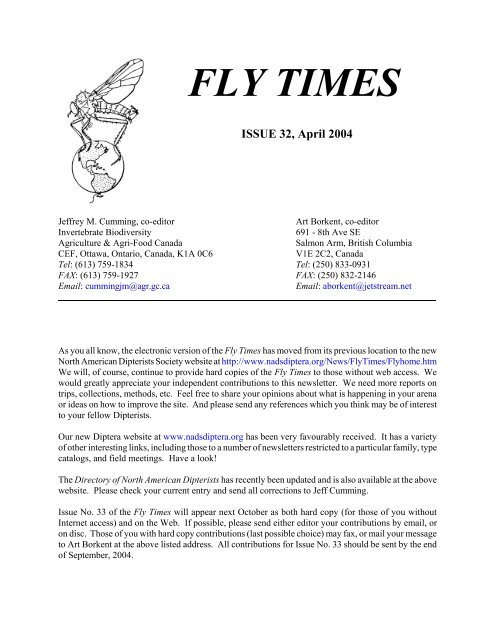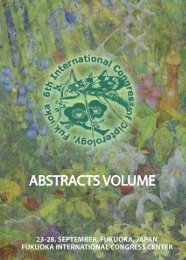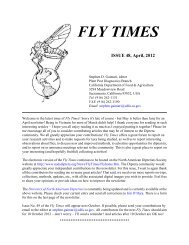Fly Times Issue 32, April 2004 - North American Dipterists Society
Fly Times Issue 32, April 2004 - North American Dipterists Society
Fly Times Issue 32, April 2004 - North American Dipterists Society
- No tags were found...
You also want an ePaper? Increase the reach of your titles
YUMPU automatically turns print PDFs into web optimized ePapers that Google loves.
2NEWSInformal Conference of <strong>Dipterists</strong> -<strong>2004</strong> Annual Meeting of the Entomological <strong>Society</strong> of Americaby C. Riley NelsonDepartment of Integrative Biology, WIDB 401, Brigham Young University, Provo,UTAH 84602 USA; rileynelson@byu.eduCome to the Entomological <strong>Society</strong> of America Annual Meetings in Salt Lake City, Utah from 14 - 17November <strong>2004</strong>. We will be having an informal conference for <strong>Dipterists</strong>, probably Tuesday evening,16 November <strong>2004</strong>. If you would like to present something in this meeting please let me know. I maybe contacting you in any case. Aside from the address above, you can reach me by phone: 801-422-1345.View from the top of Mount Timpanogos (3580m)which overlooks the meeting siteCyrtopogon auratus (Asilidae) with Docosia sp.(Mycetophilidae) prey from Mount Timpanogos***************************************XXII International Congress of Entomology Brisbane, Australia, 15-21 August <strong>2004</strong>There will be a major symposium on Diptera (Symposium Section 15) organized by David Yeates andThomas Pape called “Global Goals & Collaboration: Diptera In The 21st Century” with the followingincluded presentations:1. FLYTREE: Cooperative Research in Phylogenetics and BioinformaticsTowards a Dipteran Tree of Life: Wiegmann, Meier et al.2. Diptera Systematics on the Web: Thompson, Evenhuis3. Rewards and Challenges of Global, Collaborative Taxonomy: The ParadigmShift Offered by PEET: Lambkin, Irwin et al.
provides updates to his Tephritidae database through 1999. Finally, a special treat is Gail Kampmeier’sMANDALA, a database system for systematics and biodiversity studies.We plan to maintain a regular schedule now. So, if you have digital works about flies (Diptera) that youwant published let us know. Our next volume will be issued as soon as sufficient new material isreceived or by the latest, March 2005.5***************************************Neotropical Diptera at Utah State Universityby D.J. BickelAustralian Museum, 6 College Street, Sydney, NSW 2010, Australiadanb@austmus.gov.auI would like to alert <strong>Dipterists</strong> to the existence of a large and significant collection of NeotropicalDiptera at Utah State University, Logan. This collection has been overlooked and little publicised, butit has more unsorted Neotropical material than many well-known <strong>North</strong> <strong>American</strong> institutions.I first became aware of this collection during a conversation with Frank Parker, a retired Utah State beetaxonomist, who was returning from a collecting trip in Western Australia. When I told him of myinterest in Costa Rican Dolichopodidae, he told me that he had collected extensively in Costa Rica, andthat all the specimens were deposited at Utah State, which had a very large Neotropical collection. Thiswas news to me, as I thought I had seen most of the important collections.So I wrote to Dr. Wilford Hanson, emeritus curator of the USU Collection, and he replied that severalUSU staff (primarily George Bohart, Frank Parker and Wilford Hanson) had collected many times inSouth and Central America, and as a result, USU had amassed a large Neotropical collection. Thematerial was all mounted and sorted to family, and he estimated there was about 12-13,000Dolichopodidae. There was no question, I had to visit.So, last October, en route to the eastern U.S., I stopped at Salt Lake City, rented a car and drove up toLogan, Utah, about 1 ½ hours north of the airport. Logan is the principal city in the Cache Valley andadjoins National Forest in the Wasatch Range. I spent three days at the collection, more or less flat out,sorting Neotropical Dolichopodidae to subfamily or genus.The specimens are nicely mounted, pinned or glued to sides of pins, and sorted to family in unit traysand Cornell drawers. They comprise mostly Malaise trap material from dry heads. The dry catches werelayered in the field and brought back to Logan for subsequent mounting and labelling. I was particularlypleased to see a lot of tiny Dolichopodidae (less than 2.0 mm), suggesting that a fairly completerepresentation of the Malaise trap material had been mounted.Will Hanson told me a collecting party would often stay for some two weeks in ecotourist hostelsadjacent to unmodified habitat, and trap nearby. Many of the sites were visited repeatedly over the yearsat different seasons. The collection, roughly in order of decreasing abundance, comprises material from
6sites in Costa Rica (much material), Brazil (Rondonia, Minas Gerais, & São Paulo), Ecuador, Mexico(several states) Belize, Honduras, Peru, Jamaica, and other countries. The Rondonia material (fromseven collecting trips) is particularly valuable, not only because that state is rarely represented incollections (at least outside of Brazil), but Rondonia is undergoing rapid agricultural transformation andmuch of its natural habitat has disappeared.Most of the USU material is from lowland sites (< 500 m), and while sorting I obtained a certain “feel”for what comprised the lowland dolichopodid fauna spread across much of Central and South America.Certainly I found this material quite different in generic composition to what I am used to seeing fromsay, Monteverde in Costa Rica.My efforts were well rewarded. For example, in the Sciapodinae I borrowed, I have found three newCosta Rican species that weren’t represented in collections from INBio or elsewhere.This is an important collection of Neotropical Diptera. It is mostly unsorted beyond family level, but ifmy experience with the Dolichopodidae is any indication, the USU collection is a gold mine. Forfamilies with large or medium sized holdings, I recommend a visit of one or two days for basic sorting,even extractive sorting, since sending large volumes is a heavy curatorial load on a small staff. And, avisit is certainly worthwhile since the personnel are most helpful and the adjacent ranges of northernUtah offer many opportunities for exploration.For more information on the Utah State University Insect Collection, contact:Dr. Carol D. von Dohlen, Director (cvond@biology.usu.edu)Dr. Wilford J. Hanson, Professor Emeritus, Curator (insect@biology.usu.edu)Mr. Colin Brammer (Ph. D. candidate), Graduate Assistant (flygene@biology.usu.edu)***************************************The Black Flies (Simuliidae) of <strong>North</strong> AmericaA massive, superbly illustrated tome on the black flies of <strong>North</strong> America by Peter Adler, Doug Currieand Monty Wood was published by Cornell University Press and the Royal Ontario Museum in <strong>April</strong><strong>2004</strong> (see entry in Books and Publications below). A book launching was held in Ottawa, with Adlergiving a departmental seminar tolocal and visiting entomologists onthe current state of knowledge of thisnow very well known family of fliesfor the region.Doug Currie, Peter Adler and Monty Woodat the Canadian National Collection ofInsects in Ottawa, <strong>April</strong> <strong>2004</strong>
7Diptera from Kenya available for Systematic studiesby Bradley J. SinclairZoologisches Forschungsinstitut und Museum Alexander Koenig,Adenauerallee 160, 53113 Bonn, Germany; b.sinclair.zfmk@uni-bonn.deFor a number of years, colleagues of mine at Museum Koenig (ZFMK) have been involved inbiodiversity surveys of Kakamega Forest in Kenya. This forest represents the eastern-most branch of theGuineo-Congolian rainforest block, situated at 1400 to 1700 m a.s.l. in western Kenya. The area hasprotected status as National Forest Reserve and includes both primary and secondary rainforest, as wellas several isolated fragments. For more information on the site see: http://www.biota-africa.org/1024/biota_east/structure_east.htm.Some of the Diptera from these surveys is now available for further study, collected primarily by malaiseand coloured pan traps. The Diptera has been separated from other insects and is stored in ethanol. If youare interested in material from this locality, please contact me (b.sinclair.zfmk@uni-bonn.de) and wecan discuss how to proceed. Some of the material is in poor condition, but there are long series available.Material includes a good range of calyptrates, acalyptrates, Syrphidae, Pipunculidae, someDolichopodidae, Empididae s.l., Stratiomyidae, and misc. nematocerous Diptera.Some recent papers that included material from past survey years include:Brake, I. & Freidberg, A. (2003): Revision of Desmometopa Loew (Litometopa Sabrosky) (Diptera:Milichiidae), with descriptions of six new species. Proceedings of the Entomological <strong>Society</strong> ofWashington 105: 265-282.Scarbrough, A.G. & Marascia, C.G. (2003): Revision of Ommatius Wiedemann (Diptera: Asilidae). IV.Pygommatius subgen. nov. with twenty-five Afrotropical species. Zootaxa 228: 1-94.***************************************Biosystematic Database of World Dipteraby Irina Brake & F. Christian ThompsonSystematic Entomology Lab., USDA c/o Smithsonian Institution, MRC-0169 NHB,PO Box 37012, Washington, DC, 20013-7012, USA; cthompso@sel.barc.usda.govWe are pleased to announce a major expansion of the BioSystematic Database of World Diptera. Wehave just uploaded version 6.1 of the Nomenclator and 3.0 of the Reference database. Go to:http://www.sel.barc.usda.gov/Diptera/biosys.htm This version went online in February and is availableon volume 2 of the Diptera Data Dissemination Disk.The Nomenclator now contains the basic information on 198,773 fly names, and the Reference databasehas 11,868 citations. While some fossil names are included and a few non-Diptera names, which oncewere applied to flies, the majority of names relates to extant flies of 151 families, 10,793 genera and 144,
9New Dipterist Curator in Sao Pauloby Dalton S. AmorimDepto. de Biologia, Faculdade de Filosofia, Ciencias e Letras de Ribeirao Preto,Universidade de Sao Paulo, Avenida Bandeirantes 3900, 14040-901 Ribeirao Preto,Sao Paulo, Brasil. dsamorim@usp.brThis is to announce that Carlos Lamas is the new curator at the Diptera collection at the Museu deZoologia in Sao Paulo. He has a Masters degree from the Museu Nacional in Rio, working with MarciaCouri, and his Ph.D. working with Nelson Papavero. He has published mainly on the Bombyliidae, buthe will be in charge of the entire Diptera collection in Sao Paulo. The five members of the selectioncommittee were unanimous in appointing him for the position. I am sure he will make his new e-mailavailable to all when he arrives officially at the Museum.***************************************More Comings and GoingsShaun Winterton has taken a permanent position at the California Department of Food and Agriculturein Sacramento to work with Steve Gaimari, Eric Fisher and Peter Hibbs Kerr. Jade Savage recentlyreceived her Ph.D from McGill University and has accepted a faculty position at Bishop's University inLennoxville, Quebec, which she will start in July. Scott Brooks has just submitted his Ph.D. thesis atMcGill and will be taking a permanent position in Ottawa to work with Jeff Cumming on Empidoidea.Further afield, rumour has it that Thomas Pape has accepted a position at the Zoologisk Museum inCopenhagen. Finally, Art Borkent has moved 20 km north to Salmon Arm (see address on front page),apparently in response to global warming.***************************************<strong>Fly</strong>-By DissectionFrom Mike Borkent (another F1 of Art Borkent’s)So .... there are three men practising sword fighting: an Hymenopterist, a Lepidopterist, and a Dipterist.They were all trying to show off to each other. A fly came into the room. The Hymenopterist said"Watch this," swung his sword and the fly fell in half onto the floor. The Lepidopterist said "Oh, yeah,"and swung at another fly that was in the room, cutting it into four pieces. They felt they had both outdonethe Dipterist, but he had to give it a try. The next fly came into the room, the Dipterist went swish-swishswish,and the fly kept on flying. The Dipterist seemed proud of himself. The Hymenopterist andLepidopterist said "Hey, why are you so happy? You didn't kill it!" But the Dipterist just smiled, leanedon his sword, and said "Oui, but he'll never mate, again!"(the original nationalities have been changed to protect the culturally sensitive)
10Graduate Assistantship: Biodiversity & Phylogenetics of DipteraFull-year assistantship available to study the diversity and phylogenetic relationships of true flies(Diptera). The project is part of a massive National Science Foundation program called Assembling theTree of Life. Research team includes entomologists, biologists, and geneticists from Iowa StateUniversity, <strong>North</strong> Carolina State University, Wayne State University, Australia's CommonwealthScientific and Industrial Research Organization, the National University of Singapore, and several othercollaborating institutions. Depending on interests and experience of applicant, the student will focuson the phylogenetics of lower Diptera (aka “Nematocera”). Competitive stipend, including summersupport. Applications for either M.Sc. or Ph.D. accepted, Ph.D. preferred. Starting date summer or fall<strong>2004</strong>.For more details about the Tree of Life project, other research in the Courtney lab, and generalinformation about the Department of Entomology and the Ecology & Evolutionary Biologyinterdepartmental graduate program, contact Greg Courtney, Department of Entomology, <strong>32</strong>22 ScienceII, Iowa State University, Ames, Iowa, USA 50011; TEL 515-294-4017; FAX 515-294-5957; e-mailgwcourt@iastate.edu; website http://www.ent.iastate.edu/dept/faculty/courtney.htmlApplication forms for admission to the Graduate College are available at http://www.gradcollege.iastate.edu/forms/forms.html.Also required are official GRE scores (including Biology subjecttest), official transcripts, three letters of recommendation, and a formal statement of research interests.***************************************Books and Publications(with thanks to Chris Borkent for completing a literature search)Adler, P.H., D.C. Currie and D.M. Wood. <strong>2004</strong>. The black flies (Simuliidae) of <strong>North</strong> America. CornellUniversity Press, Ithaca. 941 pp. ISBN 0-8014-2498-4. US $99.95 plus $5.00 for postage andhandling. Order from publisher at orderbook@cupserv.org or by fax at 1-800-688-2877 or byphone at 607-277-2211. This book treats each of the 255 species of black flies known fromAmerica north of Mexico, including 43 new species. The book is copiously illustrated withmore than 1100 figures, including colour drawings of larvae and adult scutal patterns.Introductory chapters include history of research, techniques, morphology and cytology,economic impact and pest management, as well as phylogeny and classification.Blagoderov, V. and D. Grimaldi. <strong>2004</strong>. Fossil Sciaroidea (Diptera) in Cretaceous ambers, exclusive ofCecidomyiidae, Sciaridae, and Keroplatidae. <strong>American</strong> Museum Novitates 3433:1-76.Brown, B.V. 2003. In memory of Laurence W. Quate (1925-2002). Studia Dipterologica 10:353-356.Chubareva, L.A. and N.A. Petrova. 2003. Karyotypes of blackflies (Diptera, Simuliidae) of the worldfauna. Entomologicheskoe Obozrenie 82:157-222.Gagne, R.J. <strong>2004</strong>. A catalog of the Cecidomyiidae (Diptera) of the world. Memoirs of theEntomological <strong>Society</strong> of Washington 25:1-408. US $50.00 plus $5.00 for postage andhandling. Order from mpogue@sel.barc.usda.gov This catalog lists the 5,451 species and 598genera of living and fossil Cecidomyiidae or gall midges of the world. It provides information
on species distribution, hosts, and types, and original and subsequent helpful references. Withinsubfamilies, genera are listed in alphabetical order, but each are cross referenced in an appendixwhere the genera are arranged in an annotated classification. One new species is named, manynew names, new synonyms, and new combinations are proposed, and several type species aredesignated, all listed in a separate appendix. An index lists all names including hosts, withfamily given for plant hosts, family and order for animal hosts, and order for fungal hosts. Onegenus and 49 additional species have been added that were published since the manuscript wentto the publisher. A yearly update on the web is planned.Geller-Grimm, F. 2003. Fotoatlas und Bestimmungsschlüssel der Raubfliegen Deutschlands/Photographic atlas and identification key to the robber flies of Germany (Diptera: Asilidae). CD-ROM, Ampyx-Verlag , Halle (Saale), ISBN: 3-9<strong>32</strong>795-18-0. 25.00 Euro. Order from publisher,Dr. A. Stark: stark@ampyx-verlag.de or by fax at 0049/345/5226726. This CD-ROM is in bothGerman and English. The atlas contains more than 1900 photographs of 81 robber fly species.The identification key is applicable to all species of Asilidae found in Belgium, Denmark,Germany, United Kingdom, Netherlands, and Sweden.Grichanov, I.Y. <strong>2004</strong>. Review of Afrotropical Dolichopodinae (Diptera: Dolichopodidae).St.Petersburg: VIZR RAAS, <strong>2004</strong>. 244p. (Plant Protection News, Supplement). Can be orderedfrom author: grichanov@mail.ru or grichanov@hotbox.ruLaamanen, T.R., F.T. Petersen and R. Meier. 2003. Kelp flies and species concepts: The case ofCoelopa frigida (Fabricius, 1805) and C. nebularum Aldrich, 1929 (Diptera: Coelopidae).Journal of Zoological Systematics and Evolutionary Research 41:127-136.Lambkin, C. L. and D.K. Yeates. 2003. Genes, morphology and agreement: Congruence in Australiananthracine bee flies (Diptera: Bombyliidae: Anthracinae). Invertebrate Systematics 17:161-184.Mohrig, W. 2003. Black fungus gnats of Central America. Part I. (Diptera, Sciaridae). Beitraege zurEntomologie 53:1-69. Includes discussion of zoogeographic affinities.O'Hara, J.E. and D.M. Wood. <strong>2004</strong>. Catalogue of the Tachinidae (Diptera) of America north of Mexico.Memoirs on Entomology, International 18. 410 pp. This hardbound book is available fromAssociated Publishers for US $75.00; e-mail assopubl@yahoo.com or visithttp://www.mapress.com/AP/index.htmlPollet, M.A.A. S.E.Brooks and J.M.Cumming. <strong>2004</strong>. Catalog of the Dolichopodidae (Diptera) ofAmerica north of Mexico. Bulletin of the <strong>American</strong> Museum of Natural History 283: 1-114.Pratt, H.D. 2003. The winter crane flies of <strong>North</strong> America north of Mexico (Diptera: Trichoceridae).Proceedings of the Entomological <strong>Society</strong> of Washington 105(4):901-914. Includes a key to 28species, drawings of male genitalia, and distribution data; 17 species occur in Canada.Savage, J. 2003. Revision of the genus Thricops Rondani (Diptera: Muscidae). Insect Systematics andEvolution Supplement (61):1-143.Spironello, M and D.R. Brooks. 2003. Dispersal and diversification: Macroevolutionary implicationsof the MacArthur-Wilson model, illustrated by Simulium (Inseliellum) Rubstov (Diptera:Simuliidae). Journal of Biogeography 30:1563-1573.Wagner, R. 2003. Remarkable abdominal appendages of female Empididae and male Dolichopodidae(Diptera: Empidoidea). Entomologia Generalis 26:253-258.Wheeler, T.A. and J. Forrest. 2003. The Chloropidae (Diptera) of the Galapagos Islands, Ecuador.Insect Systematics and Evolution 34:265-280.Whitworth, T.L. 2003. A key to the puparia of 27 species of <strong>North</strong> <strong>American</strong> Protocalliphora Hough(Diptera: Calliphoridae) from bird nests and two new puparial descriptions. Proceedings of theEntomological <strong>Society</strong> of Washington 105: 995-1033.11
12Submission Form for Directory of <strong>North</strong> <strong>American</strong> <strong>Dipterists</strong>For those who have not yet sent in a synopsis of their interests for the Directory of <strong>North</strong> <strong>American</strong><strong>Dipterists</strong>, the following form is provided. Please restrict yourselves to no more than 20 words whenlisting the titles of your major projects and the animals you work with. Should any of you like to expandor modify your entries from the last list, use the form to indicate the changes.The information can be emailed, or the form completed and faxed or sent to the following address:Dr. J. M. Cumming,Invertebrate BiodiversityAgriculture & Agri-Food Canada,K.W. Neatby Building, C.E.F.Ottawa, Ontario, CANADA, K1A 0C6FAX: (613) 759-1927Email: cummingjm@agr.gc.ca***************************************Full name:FAX Number:Projects and taxa studied:Address:Email:Telephone Number:
















